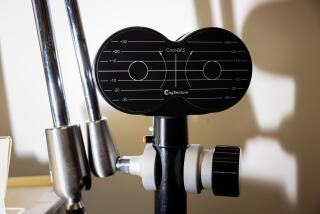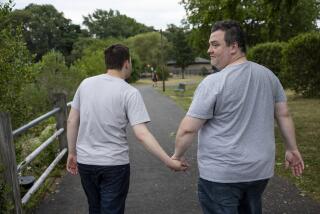A New Image for Shock Therapy : Health: Once seen as brutal and dangerous, the treatment has gained respect. Doctors and patients cite better technology, stricter standards and success when other options fail.
- Share via
When talk-show host Dick Cavett revealed recently that he had undergone electroconvulsive therapy for severe depression, he broke the ice on discussing one of medicine’s most controversial treatments.
Thousands of Americans each year receive what is widely known as ECT or electric-shock therapy; few talk about it.
ECT has made a steady resurgence over the last five years as a treatment for those with particular forms of severe mental illness. But the long-outdated and inaccurate image of it as brutal, bone-breaking and punitive has lingered.
While the social stigma persists, the negative image among doctors and patients is starting to fade.
Vast improvements in technology have led more physicians to recommend ECT. And patients are often surprised that it works when other therapies have failed.
“ECT was miraculous,” Cavett told People magazine last month. “My wife was dubious, but when she came into my room afterward, I sat up and said, ‘Look who’s back among the living.’ It was like a magic wand.”
Cavett, like many who undergo ECT, had battled depression for years but found that most antidepressants did not help.
Jill, a 47-year-old Chatsworth woman, was also helped by ECT. She has manic depression, a disorder that causes emotions to swing between extreme depression and uncontrollable euphoria. Many types of medications are available to treat depression and mania, but none worked for her for significant periods of time.
In 1991, after struggling with her disorder for 12 years, Jill received ECT at the advice of her physician. After three treatments, she began to recover.
“I’d rather drop a pill and have it work,” she says. “But ECT has given me back a real satisfactory life, which I had not experienced for a number of years.”
Unlike Cavett, Jill has told few people about her treatment and did not want her real name revealed.
“I’m still reluctant to tell people,” she says. “I’m a professional woman. As people know how highly competent I am, if they knew I had ECT, it would take a lot of explaining.”
Precise numbers are unavailable on how many people receive ECT, but experts suggest it is far more than 30,000 people annually. More psychiatric clinics and hospitals offer it than before. And some patients are even asking for it, says Dr. Richard Weiner, a Duke University psychiatrist with expertise in the therapy.
“I have had a number of people come to see me in recent months who have not had it before and specifically want to have it,” he says. “Their depressive condition has not responded to anything else, and they want to try it. Before, it was always the doctors who suggested it.”
The resurgence in ECT is based on several factors, including better equipment that delivers a much lower, safer dose of electricity and growing research on the best way to perform the therapy while minimizing side effects. In 1990, the American Psychiatric Assn. released elaborate guidelines specifying how to use it and on whom.
“Among a large segment of (physicians), it has always been something that is OK to use,” Weiner says. “It’s been used all along. But there is now more research being done and more papers on it and more acceptability. The American Medical Assn. has come out supporting it, and some of the large lay groups interested in mental health have come out in support of it.”
ECT is still used infrequently, however, and only after other treatment has been tried, experts say. The therapy is usually for people with very severe depression who are suicidal or who cannot leave their beds or homes for weeks.
Antidepressants are almost always tried first, and about 70% of people get better with medication, says Dr. Paul Wender, a psychiatrist at the University of Utah School of Medicine. But the others often need an alternative, and many of those can be helped by ECT, he says.
“At early stages and with mild cases of depression, you would try psychotherapy and, depending on the condition, maybe some antidepressant medication. The people we see (for ECT) are well past that stage,” Weiner says.
Some people with mania and schizophrenia also fail to respond to medication and may benefit. And ECT offers an opportunity for people who need help quickly. Antidepressants usually take two to six weeks, but ECT can trigger improvement after one or two treatments, experts say.
“The newer medications have fewer side effects and are better, but they do not cure everyone,” Wender says. “ECT still remains the most effective treatment for depression.”
ECT usually consists of about 12 treatments over four to six weeks. Before treatment begins, patients are anesthetized, and electrodes are placed on one or both sides of the head. Family members can wait nearby; some clinics allow them to be present during the procedure, which takes about 15 minutes.
The pulses of current cause small seizures in the brain--and one of the mysteries of ECT is that no one understands what these seizures exactly do to alleviate depression. Some research suggests they restore a balance of brain chemicals that are linked to mood disorders.
“I think it probably works very similar to how medications work,” explains Dr. Michael Frankel, chairman of the department of psychiatry at Northridge Hospital. “It stimulates the production of brain chemicals that are deficient in depression.”
Decades ago, the procedure, using a much stronger current, often caused broken bones and was used to subdue mental patients.
Says Weiner, speaking of the treatment now: “It’s pretty high-tech, and it’s pretty absent in the drama department.”
As do patients, medical students who view ECT for the first time often note that it is much different than what they had envisioned, Weiner says.
“Their comment is, ‘Is that all there is to it?’ They seem both relieved and bored,” he says.
Weiner estimates that about 5% of those with major depression receive ECT. Antidepressants are often needed to prevent the patient from relapsing.
“ECT is probably the only treatment that, once people start to respond, you stop it,” Weiner says. “It’s meant to bring people out of the episode. It doesn’t cure it.”
ECT is not without plenty of critics and controversy, however. In 1990, the San Francisco Board of Supervisors held a hearing to discuss restricting use of the treatment in the city’s hospitals. The movement failed.
Side effects remain a major drawback. Memory loss often occurs, as well as confusion (usually for a day or two) and headache, muscle ache and nausea. Severe complications, such as burns or facial bone fractures occur in about 1 out of 1,300 patients, according to the National Institute of Mental Health.
But the largest controversy surrounding ECT is over the degree of memory loss involved. Critics claim ECT “works” because it causes confusion and memory loss to the point where the patient cannot remember why he or she was depressed.
“The side effect is the treatment,” says Berkeley psychiatrist Lee Coleman. “You are clubbing the person into a state where they can’t remember their problems. This is an unpleasant explanation, so (proponents of ECT) are more comfortable saying, ‘We don’t know how it works.’ ”
Coleman, who is in private practice, says he does not believe that patients are “given a fair statement about what the risks are” when they consent to treatment.
Recent studies have attempted to clarify just how much memory loss can be attributed to ECT. Memory researcher Larry Squire of the Department of Veterans Affairs in San Diego found that patients usually cannot recall some events from about six months before ECT and that the memory loss can extend to events that occur two months after treatment. Most people also have difficulty learning information in the week or two after ECT.
But, he says, “as time passes after ECT, there is a recovery of memory. It becomes better and better. The memories formed before ECT gradually come back. But there is a gap right around ECT in which memories that would have been formed never get formed.”
Just how much memory loss is linked to ECT is hard to determine because memory can be affected by so many things--for example, the depression itself.
But, Squire says: “memory impairment is typical and part of the picture. It can’t be ignored.”
Jill says she cannot remember much of what happened in 1991 but blames that on her depression, not ECT. She undergoes “maintenance” ECT treatment every four weeks to prevent recurrences of depression. She endures some neck and head pain and confusion for about 48 hours but says she has not suffered serious memory loss.
“There is still the fright that my memory might not return right away,” she says. “But I think one of the reasons ECT works well for me is partly because of my attitude. I feel it is going to work. I have a great deal of confidence in the doctors who do it.”
Pam Vavra, 38, underwent ECT in 1989 during a severe depression that included thoughts of suicide. Vavra had tried antidepressants, but none worked for long. She decided to try ECT at the recommendation of her doctor. (Physicians must go to extraordinary lengths to explain the process and potential risks in obtaining a patient’s consent to undergo ECT. If the patient cannot make the decision, family members can authorize the treatment.)
Vavra did not get better, however, after ECT and she suffered severe side effects.
“I had extreme headaches, and I experienced tremendous memory loss afterward,” she says. “My return home (from the hospital) was as if I was walking into somebody else’s apartment. I didn’t know who I was. I didn’t know what kind of person I was.”
Still, Vavra says, she feels it was correct to try ECT.
“I’ve seen too many successes to think that it doesn’t work for others,” she says. “Despite my bad experience, I have helped to educate people about it and not to rule it out as an option.”
BACKGROUND
ECT is known to most Americans as the gruesome treatment portrayed in the movie, “One Flew Over the Cuckoo’s Nest.” In the 1940s, ECT was sometimes forced on patients in mental institutions to subdue or punish them. The treatment was crude compared to today’s methods. A much stronger current was delivered, sometimes resulting in burns, broken bones and severe pain. Use of the therapy declined in the 1960s when newer, more powerful antidepressants and antipsychotics became available. But the number of patients receiving ECT has grown since 1990, when the American Psychiatric Assn. released detailed guidelines on its use.
More to Read
Sign up for Essential California
The most important California stories and recommendations in your inbox every morning.
You may occasionally receive promotional content from the Los Angeles Times.










